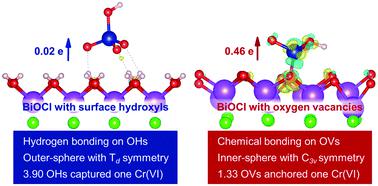当前位置:
X-MOL 学术
›
Environ. Sci.: Nano
›
论文详情
Our official English website, www.x-mol.net, welcomes your feedback! (Note: you will need to create a separate account there.)
The surface hydroxyl and oxygen vacancy dependent Cr(VI) adsorption performance of BiOCl
Environmental Science: Nano ( IF 7.3 ) Pub Date : 2020-03-19 , DOI: 10.1039/d0en00108b Guangming Zhan 1, 2, 3, 4, 5 , Jie Li 1, 2, 3, 4, 5 , Yue Hu 1, 2, 3, 4, 5 , Shengxi Zhao 1, 2, 3, 4, 5 , Shiyu Cao 1, 2, 3, 4, 5 , Falong Jia 1, 2, 3, 4, 5 , Lizhi Zhang 1, 2, 3, 4, 5
Environmental Science: Nano ( IF 7.3 ) Pub Date : 2020-03-19 , DOI: 10.1039/d0en00108b Guangming Zhan 1, 2, 3, 4, 5 , Jie Li 1, 2, 3, 4, 5 , Yue Hu 1, 2, 3, 4, 5 , Shengxi Zhao 1, 2, 3, 4, 5 , Shiyu Cao 1, 2, 3, 4, 5 , Falong Jia 1, 2, 3, 4, 5 , Lizhi Zhang 1, 2, 3, 4, 5
Affiliation

|
The migration and bioavailability of Cr(VI) are determined by its adsorption behavior, which is sensitive to the coordination environment and to the physicochemical properties of mineral surfaces, especially natural surface defects, such as surface hydroxyls (OHs) and oxygen vacancies (OVs). However, natural minerals with high percentages of surface OHs and OVs are not available, concealing the quantitative relationship between surface OHs and OVs and Cr(VI) adsorption on minerals. With regard to the easy tuning of OHs and OVs on the 001 surface of BiOCl (BiOCl-001), herein we systematically check how surface OHs and OVs influence Cr(VI) adsorption on BiOCl-001, using density functional theory calculations, in situ attenuated total reflectance Fourier transform infrared spectroscopy, and synchrotron-based Cr K-edge extended X-ray absorption fine structure spectroscopy, aiming to elucidate the contribution of surface OHs and OVs to Cr(VI) adsorption on minerals at a molecular level. The results revealed that 3.90 OHs captured one Cr(VI) in a hydrogen bonded adsorption and outer-sphere model with subtly distorted Td symmetry, and 1.33 OVs anchored one Cr(VI) by forming a Cr–O–Bi bond to produce a monodentate mononuclear inner-sphere surface complex with C3v symmetry, along with the partial reduction of Cr(VI) by unpaired electrons located in the OVs on BiOCl-001. This difference would intensely affect the mobility and long-term fate of Cr(VI) species. This study clarifies the surface defect dependent adsorption behavior of Cr(VI), and sheds light on the environmental effects of surface OHs and OVs of minerals.
中文翻译:

BiOCl的表面羟基和氧空位依赖性Cr(VI)吸附性能
Cr(VI)的迁移和生物利用度取决于其吸附行为,该吸附行为对配位环境和矿物表面的理化特性(特别是天然表面缺陷,例如表面羟基(OHs)和氧空位(OVs))敏感。然而,没有高含量的表面OH和OV的天然矿物,这掩盖了表面OH和OV与Cr(VI)吸附在矿物上的定量关系。对于OHS和OVS的的BiOCl(的BiOCl-001)的001表面上的容易调谐,本文中我们系统地检查表面OHS和OVS如何影响的Cr(VI上的BiOCl-001)吸附,使用密度泛函理论计算,原位衰减全反射傅里叶变换红外光谱和基于同步加速器的Cr K边缘扩展X射线吸收精细结构光谱,旨在阐明分子表面上表面OH和OV对矿物上Cr(VI)吸附的贡献。结果表明,在氢键吸附和外球模型中,有3.90个OHs捕获了一个Cr(VI),其T d对称性明显变形,而通过形成Cr-O-Bi键形成一个Cr(VI),1.33个OVs锚定了一个Cr(VI)。C 3v对称的单齿单核内球表面复合物,以及Cr(VI的部分还原))是由BiOCl-001的OV中的不成对电子构成的。这种差异将严重影响Cr(VI)物种的迁移率和长期命运。这项研究阐明了表面缺陷对Cr(VI)的吸附行为,并阐明了矿物表面OH和OV的环境效应。
更新日期:2020-03-19
中文翻译:

BiOCl的表面羟基和氧空位依赖性Cr(VI)吸附性能
Cr(VI)的迁移和生物利用度取决于其吸附行为,该吸附行为对配位环境和矿物表面的理化特性(特别是天然表面缺陷,例如表面羟基(OHs)和氧空位(OVs))敏感。然而,没有高含量的表面OH和OV的天然矿物,这掩盖了表面OH和OV与Cr(VI)吸附在矿物上的定量关系。对于OHS和OVS的的BiOCl(的BiOCl-001)的001表面上的容易调谐,本文中我们系统地检查表面OHS和OVS如何影响的Cr(VI上的BiOCl-001)吸附,使用密度泛函理论计算,原位衰减全反射傅里叶变换红外光谱和基于同步加速器的Cr K边缘扩展X射线吸收精细结构光谱,旨在阐明分子表面上表面OH和OV对矿物上Cr(VI)吸附的贡献。结果表明,在氢键吸附和外球模型中,有3.90个OHs捕获了一个Cr(VI),其T d对称性明显变形,而通过形成Cr-O-Bi键形成一个Cr(VI),1.33个OVs锚定了一个Cr(VI)。C 3v对称的单齿单核内球表面复合物,以及Cr(VI的部分还原))是由BiOCl-001的OV中的不成对电子构成的。这种差异将严重影响Cr(VI)物种的迁移率和长期命运。这项研究阐明了表面缺陷对Cr(VI)的吸附行为,并阐明了矿物表面OH和OV的环境效应。



























 京公网安备 11010802027423号
京公网安备 11010802027423号